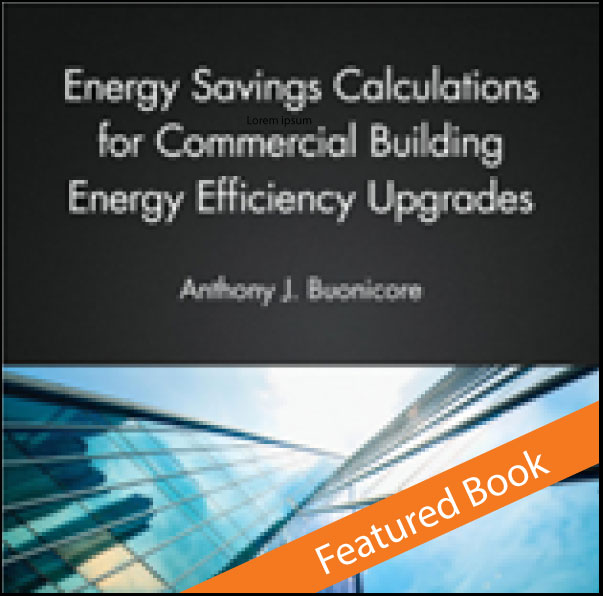
SRS Blog
Building energy efficiency insights from the innovators behind EPIC June 24, 2024
June 24, 2024
Featured Book: Energy Savings Calculations for Commercial Building Energy Efficiency Upgrades
Book Preface
This book was prepared with the energy professional and contractor in mind who is replacing existing energy-consuming equipment such as heating, cooling, ventilation, and lighting systems with new high efficiency equipment in commercial and multifamily buildings. In the U.S., there are approximately 5,900,000 non-residential commercial buildings(1) and 1,800,000 multifamily buildings (defined as having five or more units).(2) More than 95% of these buildings are less than 50,000 square feet in size and are categorized as small-to-medium size buildings (SMBs). Assuming the estimated useful life of most energy-consuming equipment in these buildings ranges between 15 to 25 years, this would mean at least 400,000 buildings each year with equipment at the end of its useful life needing to be replaced. And this does not include buildings with equipment having a remaining useful life but voluntarily being replaced by building owners. This represents a significant market particularly for energy professionals and contractors.
While institutional clients with buildings typically greater than 50,000-100,000 square feet (which is less than 5% of the U.S. building population) may be able to afford upfront, relatively expensive building simulation modeling to evaluate energy savings, most building owners cannot. The (non-institutional) building owners who need to replace equipment that is near, has reached, or exceeded its useful life, usually solicit bids from local contractors to obtain the best pricing. For competitive reasons, contractor bids typically propose the lowest price equipment complying with code. Moreover, due to a lack of expertise in calculating energy cost savings, rarely are energy cost implications even addressed. As such, making an investment case for higher efficiency equipment which usually comes at a cost premium is rarely attempted.
The principal goal of this book is to assist energy professionals, contractors, building owners and managers in cost-effectively developing energy consumption and cost savings estimates. These estimates, for example, can facilitate a quick assessment of potential savings that might be realized when replacing code-compliant equipment with higher efficiency, above code equipment. Code-compliant equipment will typically have the lower first cost, but the lifetime energy cost savings of the higher efficiency equipment can often justify the upfront cost premium and result in a more cost-effective solution. However, to justify the added expense of the higher efficiency equipment necessitates being able to provide the building owner with comparative energy savings. This book is designed to assist in this important effort. It will also assist energy professionals seeking preliminary energy savings estimates when first evaluating a project in the development phase.
Over the years, in responding to thousands of clients seeking to know the energy cost savings that might be associated with a planned energy efficiency equipment upgrade project to their existing building, I have often faced the dilemma of either using expensive, time-consuming and complicated building simulation modeling (or complicated, data intensive spreadsheets) or finding alternative more cost-effective and easier to use approaches that can quickly provide reasonable results. Moreover, it can be foolhardy to waste significant time and resources to nail things down to the last decimal place when you may not even be awarded the project, or the answer may result in something that is commercially unattractive to the building owner and cause the project to be canceled.
The problem is that while building simulation modeling may be the preferred approach, and certainly it is for buildings that are being newly constructed, the expense of using it to support the vast majority of existing building equipment replacements (particularly in the SMB market) often is not economically justifiable. Moreover, building owners usually request proposals from multiple energy professionals and contractors and are unwilling to pay at this “proposal stage” for the expensive cost of modeling. Even if building simulation modeling is approved by a building owner, it still requires a significant amount of data input, and is often accompanied by much guesswork, such as predicting future weather at the building location. As such, this book does not focus on building energy simulation modeling or data intensive spreadsheets, but rather on algorithms that can quickly provide reasonable energy savings estimates.
As part of the technical review for thousands of Property Assessed Clean Energy (PACE) projects across the country, I have used the algorithms in this book to provide quickly and cost-effectively an estimate of the energy savings associated with high efficiency equipment upgrades in existing commercial and multifamily buildings. In using these algorithms, I have found that they typically are able to estimate energy savings within +/- 20%. While this may not be as good as building simulation modeling, I have found it to be acceptable to most building owner clients.
The book is divided into seventeen chapters and begins with a discussion of the energy savings conundrum, i.e., that energy savings can mean different things to different people. The second chapter focuses on development of a whole building’s energy consumption and the energy consumption associated with building end-uses such as space heating, space cooling, ventilation, lighting, etc. Chapter 3 discusses how to establish the baseline energy consumption against which the energy savings will be estimated. Chapters 4 to 10 focus on the most common energy-consuming equipment replacements or upgrades that I have encountered, and includes a description of the equipment, the energy efficiency metrics, and the energy savings algorithms. I have included Chapters 11 and 12 on cogeneration and solar photovoltaic systems because I have found these more and more often to be considered and included with the building energy efficiency upgrade project. Since many water-saving building fixtures, such as today’s faucets and showers, can also reduce energy particularly in multifamily buildings, Chapter 13 addresses these savings.
While the book focuses on the most common equipment replacements and upgrades, there are many additional energy efficiency upgrades that can exist. Some of the more common I have encountered within the SMB market are presented in Chapter 14. Since new equipment upgrades have the potential to interact with each other, Chapter 15 considers the interactivity implications and their impact on energy savings. The chapter also focuses on the sequencing of equipment installation to avoid double counting, on methodologies to deal with mixed use buildings, and on the most common mistakes that I have encountered in project technical review.
While estimating energy consumption savings is important, it is even more important to be able to translate these savings into the language that commercial real estate owners and managers can understand, and that is their impact on cash flow. Chapter 16 focuses on financial metrics, including from personal experience typical installed costs for energy efficiency upgrades.
Finally, as climate change and greenhouse gas emissions become the political mantra, Chapter 17 provides algorithms to estimate greenhouse gas emission reductions that may be achieved by building energy efficiency upgrades and the impact these upgrades can have on building electrification-decarbonization projects.
Throughout the book I have included dozens of illustrative examples on use of the algorithms presented. It is hoped that these examples will demonstrate the value of the algorithms and how they can best be used in energy savings evaluations for clients.
If your preference is to use a software tool to do many of the calculations presented in this book, I refer you to Sustainable Real Estate Solutions’ Energy Performance Improvement Calculator (EPICTM). Additional information on this software tool may be found at: SRSworx.com
If you are interested in taking a two day in-person or four day virtual course on estimating energy savings as presented in this book, contact me directly at my email address.
(1) Commercial Building Energy Consumption Survey (CBECS), 2018.
(2) Residential Energy Consumption Survey (RECS), 2020.
The book may be ordered directly from CRC Press.
You will also find it on Amazon, Walmart Books and Barnes and Noble.


About the Author
Anthony J. Buonicore is Director of Engineering at Sustainable Real Estate Solutions. Mr. Buonicore is a licensed professional engineer with almost 50 years' experience in the commercial real estate energy and environmental industry. He may be contacted through our Contact page.

